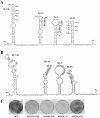cis-acting RNA signals in the NS5B C-terminal coding sequence of the hepatitis C virus genome
- PMID: 15452207
- PMCID: PMC521798
- DOI: 10.1128/JVI.78.20.10865-10877.2004
cis-acting RNA signals in the NS5B C-terminal coding sequence of the hepatitis C virus genome
Abstract
The cis-replicating RNA elements in the 5' and 3' nontranslated regions (NTRs) of the hepatitis C virus (HCV) genome have been thoroughly studied before. However, no cis-replicating elements have been identified in the coding sequences of the HCV polyprotein until very recently. The existence of highly conserved and stable stem-loop structures in the RNA polymerase NS5B coding sequence, however, has been previously predicted (A. Tuplin, J. Wood, D. J. Evans, A. H. Patel, and P. Simmonds, RNA 8:824-841, 2002). We have selected for our studies a 249-nt-long RNA segment in the C-terminal NS5B coding region (NS5BCR), which is predicted to form four stable stem-loop structures (SL-IV to SL-VII). By deletion and mutational analyses of the RNA structures, we have determined that two of the stem-loops (SL-V and SL-VI) are essential for replication of the HCV subgenomic replicon in Huh-7 cells. Mutations in the loop and the top of the stem of these RNA elements abolished replicon RNA synthesis but had no effect on translation. In vitro gel shift and filter-binding assays revealed that purified NS5B specifically binds to SL-V. The NS5B-RNA complexes were specifically competed away by unlabeled homologous RNA, to a small extent by 3' NTR RNA, and only poorly by 5' NTR RNA. The other two stem-loops (SL-IV and SL-VII) of the NS5BCR domain were found to be important but not essential for colony formation by the subgenomic replicon. The precise function(s) of these cis-acting RNA elements is not known.
Figures








Similar articles
-
A cis-acting replication element in the sequence encoding the NS5B RNA-dependent RNA polymerase is required for hepatitis C virus RNA replication.J Virol. 2004 Feb;78(3):1352-66. doi: 10.1128/jvi.78.3.1352-1366.2004. J Virol. 2004. PMID: 14722290 Free PMC article.
-
Kissing-loop interaction in the 3' end of the hepatitis C virus genome essential for RNA replication.J Virol. 2005 Jan;79(1):380-92. doi: 10.1128/JVI.79.1.380-392.2005. J Virol. 2005. PMID: 15596831 Free PMC article.
-
Inhibition of hepatitis C virus replication by pol III-directed overexpression of RNA decoys corresponding to stem-loop structures in the NS5B coding region.Virology. 2005 Nov 25;342(2):276-85. doi: 10.1016/j.virol.2005.08.003. Epub 2005 Sep 1. Virology. 2005. PMID: 16139319
-
Cis-acting RNA elements in human and animal plus-strand RNA viruses.Biochim Biophys Acta. 2009 Sep-Oct;1789(9-10):495-517. doi: 10.1016/j.bbagrm.2009.09.007. Epub 2009 Sep 23. Biochim Biophys Acta. 2009. PMID: 19781674 Free PMC article. Review.
-
Coronavirus cis-Acting RNA Elements.Adv Virus Res. 2016;96:127-163. doi: 10.1016/bs.aivir.2016.08.007. Epub 2016 Sep 6. Adv Virus Res. 2016. PMID: 27712622 Free PMC article. Review.
Cited by
-
Identification of a structural element of the hepatitis C virus minus strand RNA involved in the initiation of RNA synthesis.Nucleic Acids Res. 2010 Jul;38(12):4079-91. doi: 10.1093/nar/gkq109. Epub 2010 Mar 1. Nucleic Acids Res. 2010. PMID: 20194114 Free PMC article.
-
The hepatitis C virus RNA 3'-untranslated region strongly enhances translation directed by the internal ribosome entry site.J Virol. 2006 Dec;80(23):11579-88. doi: 10.1128/JVI.00675-06. Epub 2006 Sep 13. J Virol. 2006. PMID: 16971433 Free PMC article.
-
A hepatitis C virus cis-acting replication element forms a long-range RNA-RNA interaction with upstream RNA sequences in NS5B.J Virol. 2008 Sep;82(18):9008-22. doi: 10.1128/JVI.02326-07. Epub 2008 Jul 9. J Virol. 2008. PMID: 18614633 Free PMC article.
-
Functionally conserved architecture of hepatitis C virus RNA genomes.Proc Natl Acad Sci U S A. 2015 Mar 24;112(12):3692-7. doi: 10.1073/pnas.1416266112. Epub 2015 Mar 9. Proc Natl Acad Sci U S A. 2015. PMID: 25775547 Free PMC article.
-
Anti-HCV RNA Aptamers Targeting the Genomic cis-Acting Replication Element.Pharmaceuticals (Basel). 2011 Dec 28;5(1):49-60. doi: 10.3390/ph5010049. Pharmaceuticals (Basel). 2011. PMID: 24288042 Free PMC article.
References
-
- Adachi, T., H. Ago, N. Habuka, K. Okuda, M. Komatsu, S. Ikeda, and K. Yatsunami. 2002. The essential role of C-terminal residues in regulating the activity of hepatitis C virus RNA-dependent RNA polymerase. Biochim. Biopsy. Acta 1601:38-48. - PubMed
-
- Berkhout, B., B. F. Schmiht, A. van Strien, J. H. van Boom, J. van Westrenen, and J. van Duin. 1987. Lysis gene of bacteriophage MS2 is activated by translation termination at the overlapping coat gene. J. Mol. Biol. 195:517-524. - PubMed
-
- Blight, K. J., A. A. Kolykhalov, and C. M. Rice. 2000. Efficient initiation of HCV RNA replication in cell culture. Science 290:1972-1974. - PubMed
Publication types
MeSH terms
Substances
Grants and funding
LinkOut - more resources
Full Text Sources
Other Literature Sources
Research Materials

